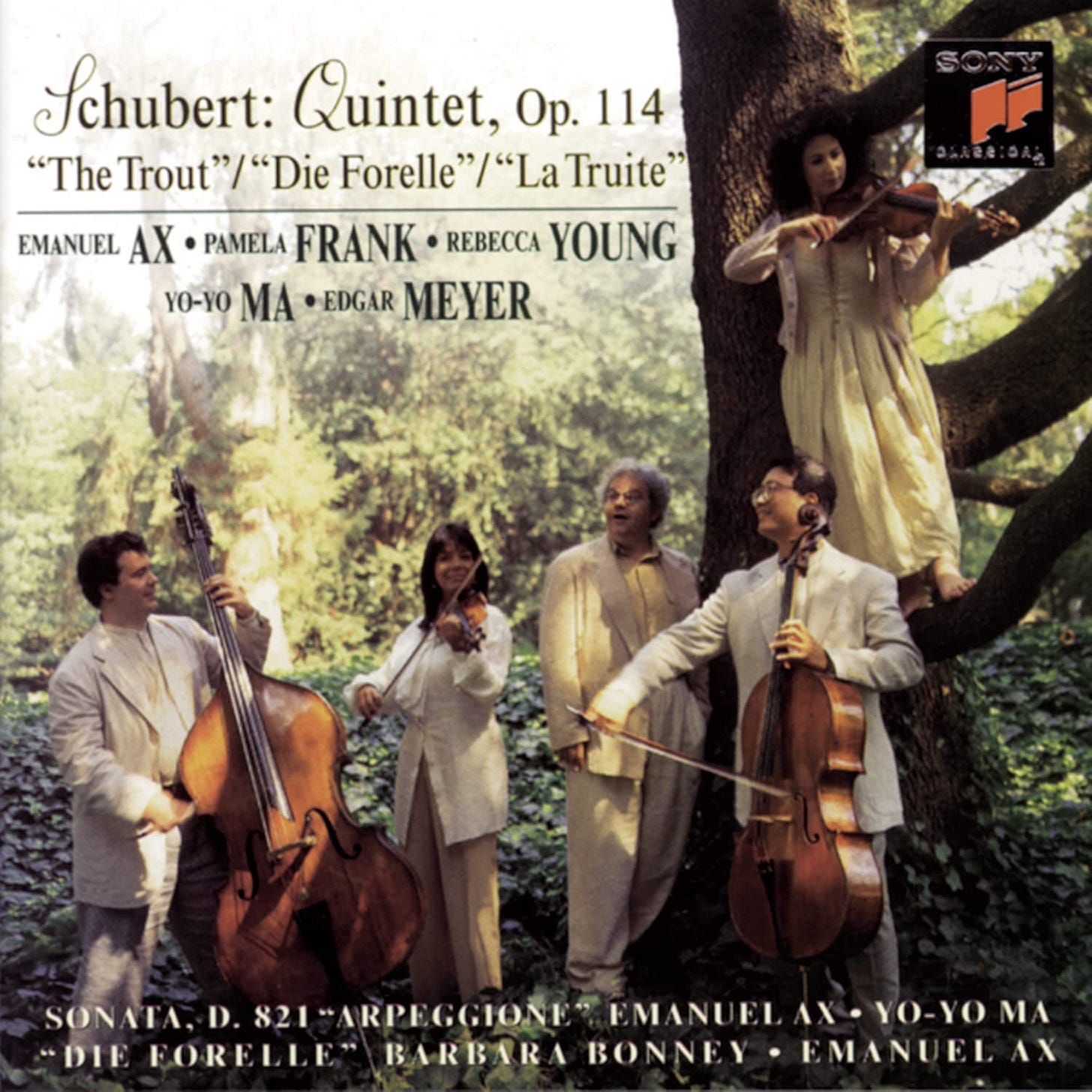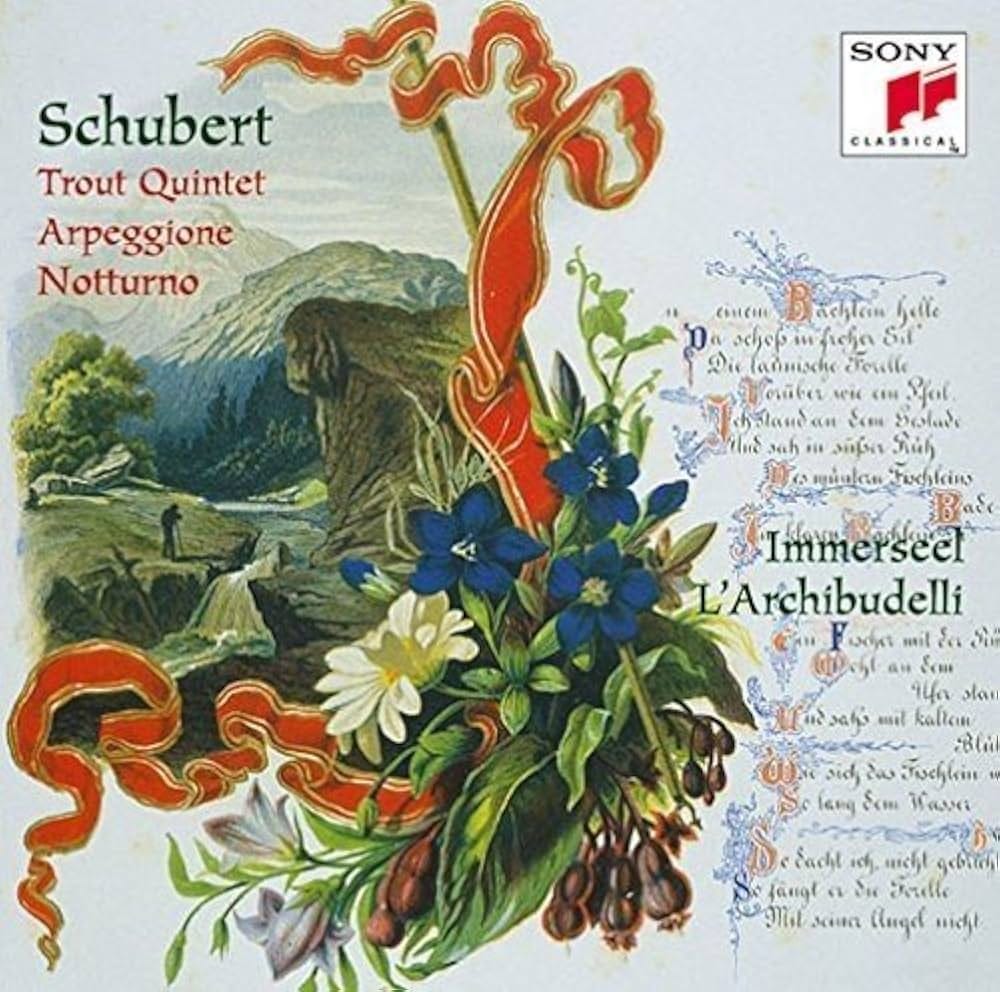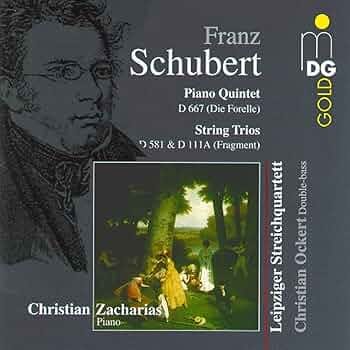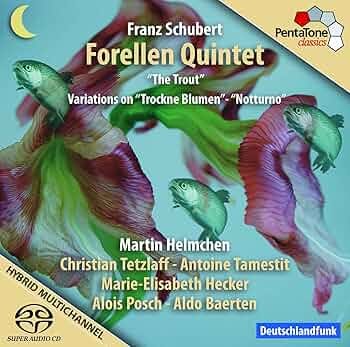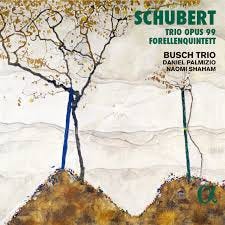Building a Collection #87
Piano Quintet in A major, “Trout”
By Franz Schubert
____________
“I am composing like a god, as if it simply had to be done as it has been done.”
-Franz Schubert
At #87 we encounter one of the most joyful and tuneful pieces of chamber music ever composed, Franz Schubert’s Piano Quintet in A major, also known as the Trout Quintet.
Franz Schubert
Franz Schubert was born in 1797 in Vienna and died in 1828 in Vienna. In his tragically short life, Schubert became one of the greatest composers of all-time. Franz Liszt said of Schubert that he was, “...the most poetic of them all.” Schubert lived at the end of the Classical period, and at the very beginning of the Romantic period. At heart, Schubert was a romantic. Schubert was the one mostly responsible for bringing the art of song (lieder) to the forefront of classical music. He produced great works in nearly every genre: orchestral, symphonic, lieder, keyboard, chamber music, choral, and opera. Schubert possessed a tremendous gift for melody and harmony, and he expanded upon the classical forms used primarily at the time.
Schubert played music at home with his family, and eventually was enrolled in a school for young vocalists to sing at the imperial court. Schubert began composing on his own, and some of his songs came to the attention of the director Antonio Salieri (yes, the same Salieri associated with Mozart). He was proclaimed a genius, but after his voice broke, he was sent back to his family. His father insisted that he become a teacher and follow in his footsteps. While the young Schubert agreed, at night he would compose furiously. Schubert had composed hundreds of works of many genres before the age of 20.
Schubert eventually staked out on his own, taught some piano lessons, and was commissioned in 1820 to write operas for two of the opera houses in Vienna. Unfortunately, the productions were not well-received perhaps owing to Schubert’s inventive harmonies and breakthrough style which were not accepted yet. He struggled to obtain a contract from any publishers, and even though he published his own works for subscribers, he was barely scraping by financially. Then in 1823, Schubert was elected as an honorary member of the Musikverein in Graz, Austria. While relatively inconsequential in reality, Schubert enjoyed the recognition and took the opportunity to write his famous Unfinished symphony (these days numbered as his 8th symphony). Later, Schubert’s music was featured at a concert at the legendary Musikverein in Vienna, where his music finally received an enthusiastic reception. This may have been one of the few happy times in Schubert’s life, as he soon became ill from syphilis (although more recent scholarship reveals that he actually died from typhoid). A shy, introverted, and humble man, Schubert was often lost in his own thoughts and was known to suffer from depression and even suicidal thoughts. Despite his illness, he continued to compose at an incredible rate. Schubert requested to be buried alongside Ludwig van Beethoven, whom he greatly revered. He was also grateful for Beethoven’s positive reception of his music. Schubert also loved the music of Mozart and Haydn.
Schubert’s finest works include songs such as Gretchen am Spinnrade (Gretchen at the Spinning Wheel), Erlkonig, Ave Maria (no doubt you have heard), song cycles Die Schone Mullerin (The Beautiful Miller), Die Winterreise (Winter Journey), Symphonies 8 and 9 (“Unfinished” and “The Great”), the “Trout” Quintet, String Quintet in C major, Impromptus for piano, Piano Sonatas, “Death and the Maiden” Quartet, and his Deutsche Mass among others.
Piano Quintet in A major, “Trout”
Franz Schubert was the greatest composer of German lied (song), and he composed the song Die Forelle (“The Trout”) 1817 for solo voice and piano. The song tells the story of a trout being caught by a fisherman, but the actual meaning of the song was a warning to young women to guard against young men. Schubert was to make several edits, and eventually it could be sung by a woman or man. But the song was so tuneful and popular that Schubert received a commission from a wealthy patron to develop it into a set of variations.
Schubert embarked on composing a piano quintet which incorporated Die Forelle and variations as the fourth movement. This quintet was unusual, in that it used piano, violin, viola, cello and double bass rather than the standard piano and string quartet. Schubert completed it in 1819 at the age of 22 (sadly Schubert would die in 1828 at the age of 31). However, the quintet would never be published in his lifetime, only being published in 1829, a year after his death. The nickname, of course, comes from the melody of the song Die Forelle included as the lyrical fourth movement.
Thus it was that what we now call the Trout Quintet began its life, and oh what a life it has been for this ever popular piece of chamber music. Undoubtedly one of the most melodic, accessible, and purely enjoyable pieces of music ever written, it is also an important work in the sense that Schubert made use of innovative harmonic structures, chromaticism, and the way the piano is interwoven with the strings, and in particular the violin.
It is an intimate work, and something it would make sense to hear at a dinner party, or in someone’s home. This music is so delightful as to completely disarm the listener, so the only thing to do is sit back and enjoy. As Michael Clive, annotator for the Pacific Symphony says:
“Is there a more self-effacing genius in the history of music than the great Franz Schubert? Cheerful and unassuming, he viewed as a blessing any opportunity to bring the enjoyment of music to any listener…Now-legendary tales of his scrawling songs on napkins (he wrote over 600 of them) suggest a Mozartean divine child channeling beautiful melodies from God.”
What Schubert taps into here is musical language that everyone can understand, as we immediately sense its charm, radiance, and sunny disposition. This is different from much of Schubert’s music, which often contained tragic undertones and conflict. But the Trout is feel-good music, and we don’t need any excuse to enjoy it.
The quintet consists of five movements:
Allegro vivace
Andante
Scherzo: Presto
Andantino – Allegretto
Allegro giusto
Alex Burns, in his excellent summary of the Trout, explains each movement:
I. Allegro vivace
The opening movement is set in sonata form, which was common practice for the time of composition. By far the longest of all five movements, this opening movement sets the tone of the whole quintet. What makes this particular quintet exciting is Schubert’s innovative harmonic writing. Instead of just adhering to expectant tonic and dominant shifts in the structure, he also uses mediants and submediants to create musical color and excitement.
With abrupt harmonic shifts the music quickly moves through each section of the form. The end of the exposition section ends in E major and suddenly switches into C major for the development section. This keeps the music exciting and the listener on the edge of their seat as to what might happen next.
The violin and piano dominate the melodies of this movement, with the other strings playing a much more accompaniment-led part. The instruments intertwine and create colorful patterns of music that just fizz with classic Schubert flair.
II. Andante
The expressive second movement, marked ‘Andante’, is composed of two symmetrical sections. The second section is a transposed version of the first, which again exploits Schubert’s developmental harmonic language. The movement ends in the key that it started in – F major – however the journey between the two is full of twists and turns. Again, the violin and piano take dominance over the melodic material, with the others accompanying off-beats and constant quaver movement.
III. Scherzo: Presto
The spritely third movement is the one that doesn’t quite follow the unifying theme idea. There is a lot of call and response happening in this movement between the upper and lower instruments which creates drama in the music. Schubert’s use of dynamics in this movement is also pertinent, with unifying moments being louder than the more solo-led passages. The fun-loving melody keeps returning, creating a sense of familiarity for the listener.
IV. Andantino – Allegretto
The much-anticipated fourth movement is a theme and variations on Schubert’s Die Forelle. The variations take the original melodic content and use decorations such as trills and mordents to create the variations. The theme is passed around each instrument with each member of the quintet portraying a variation.
Schubert varies the mood for each of the variations. For instance, the opening violin variation is much more solemn than the perky piano variation after it. After continually modulating, the movement unifies the instruments at the end to finish in the opening key once more.
V. Allegro giusto
Similarly to the second movement, the final movement also has two symmetrical sections. Again, Schubert utilizes harmony in this movement and soon begins to move around various keys, which was largely contradictory to the usual Classical style. You can hear lots of call and response between the instruments, with particularly important lines being emphasized by the whole quintet.
A cascading piano motif ends up being a quasi-cadenza as the instruments soon jump back in to create an exciting polyphonic texture. The final movement ends with contrasting loud and quiet calls and responses between the quintet before they unite for the grand last three chords.
The Essential Recording
I’m not sure there are any actual trout near your proverbial desert island, unless it is in the middle of a lake, but nevertheless there is one recording of this wonderful work that you should definitely take with you: the Trout Quintet performed by the great pianist Clifford Curzon and members of the Vienna Octet, recorded by Decca in 1957 in the warm acoustic of the old Sofiensaal in Vienna. There is an intimacy to this recording that feels as though you are sitting among the musicians, and you can literally hear the resin on the strings being played. The piano is slightly recessed, but Curzon adds color and personality aplenty, though he is also refined and aristocratic. There are many examples of personality and wit, and when the crescendo happens in the first movement we feel the tension before a delightful and sparkling allegro. The group also knows when to pull back, and their tenderness and emotion is unmatched, but when things accelerate again we hear the passion and urgency. This group is in no hurry, and that is all the better in order to savor every note. The wonderful Willi Boskovsky from the Vienna Philharmonic on violin is a treat to hear. From a sonic point of view, the recording is lacking some depth, especially with the lower strings. But this is more than compensated for by the lyricism and the “joie de vivre” of the entire recording. You are unlikely to ever hear the famous fourth movement variations done with more style, elegance, and warmth than it is here.
In summary, this is a radiant, charming reading full of spontaneity, but without the eccentricities or inconsistencies of other recordings. It has stood the test of time.
Recommended Recordings
Legendary pianist Arthur Schnabel and the Pro Arte Quartet on Warner/Beulah, in a recording from 1935, obviously have sound limitations. Still, this is playing of tremendous grace, spontaneity, and feeling. The sound is remarkably good for its day, and Schnabel is in excellent form. The Pro Arte group was known for more romantic repertoire, while Schnabel was more known for his interpretations of classical composers. But it turned out to be a good match, with all involved sensitive to the others. The phrasing is a constant delight, and while the playing is by no means flawless, this is an important historic document of a highly enjoyable performance.
Rudolf Serkin was one of the greatest pianists of the 20th century, and his recording of the Trout from the Marlboro Music Festival, recorded in 1967 by CBS/Columbia (now Sony) remains one of the best accounts overall. He is joined by violinist Jaime Laredo, Julius Levine, Leslie Parnas, and Phillip Naegele. There is a great deal of joy and sparkle to this performance, and the Scherzo and Finale especially are played with freshness and confidence. I admire how cohesive the group is, but Serkin and Laredo stand out for their brilliance. The sound is not ideal, with some thin sound at the top that gives the violin and viola an astringent quality. But the engaging quality of the performance trumps those reservations.
Finally in the recommended category is the 1976 recording by the Beaux Arts Trio along with Samuel Rhodes and Georg Maximilian Hörtnagel. This is the closest thing in my mind to what Curzon and team achieved, but with better sound. There is lovely, creamy string tone together with pointed accents, buoyancy, and a leisurely pace. The sound is full and clear, and it is well-balanced. The Andante and the Variations play to the group’s romantic strengths, and the fluidity, depth, and warmth are palpable. This is sublime musicianship, not high on the exciting scale, but certainly charming and moving. The playing is refined and noble, with Menahem Pressler on piano in particular very effective in setting the tone. They take us on a journey, and it is thoroughly delightful and idiomatic for Schubert. When a cohesive group such as the Beaux Arts, caught in their prime, comes together for such a wonderful work, great things are expected. They certainly deliver.
Legendary Russian pianist Emil Gilels recorded the Trout Quintet with the Amadeus Quartet in 1976 for the Deutsche Grammophon label. Gilels is simply terrific here, perhaps not quite as warm as Curzon, but more impressive overall in his grandeur, phrasing, and energy. Overall the sound is better than in the Curzon account, and the group has a more consistent forward momentum. The balance is exceptional with how the strings and piano are kept in perspective. If the Curzon version is more “romantic” in nature, this one is more “classical” in its approach. In the Scherzo, the way the violin articulates some of the notes is off-putting to me personally. Nevertheless this is very appealing, especially for the excellent contributions from Gilels.
In 1996 when Sony released the recording of the Trout Quintet with the starry lineup of Yo-Yo Ma, Emmanuel Ax, Pamela Frank, Rebecca Young, and Edgar Meyer (with the song Die Forelle added as a bonus sung by the incomparable Barbara Bonney), I have to admit I did not take it seriously because I thought it might be too gimmicky. I was wrong. The sound and balance of instruments is nearly perfect, and there is a sense of atmosphere around the recording. The articulation is light and buoyant, with Ax on piano and Frank on violin leading the proceedings with a lovely singing tone. Tempos are well-thought out and dynamic changes are very effective. The crescendo in the first movement is impactful and just right, and I can sense how the music really communicates with the listener. The second movement is wistful, romantic, and graceful. The phrasing is unified and expressive, but not sappy. The Scherzo is exuberant, lively, and infectious, played with true verve. It is one of the fastest Scherzos you will hear, and while I prefer some more air around the notes, this is undeniably exciting. The Variations are heartfelt and tender, and the Finale has a sense of flow that leads to a satisfying conclusion. One of the best versions available.
The only period instrument entry in the top recommendations is the 1998 recording by Jos van Immerseel on fortepiano, Anner Bylsma on cello, and L’Archibudelli Trio on the Sony label. While I remain unconvinced about the Trout on period instruments, this performance goes a long way toward making the case. There is a lightness to the sound, maybe a bit underweight in some places, and the fortepiano has less resonance than a modern piano. The strings are rather astringent as is typical with period instruments, but rhythms are freshly sprung and dance-like. Bylsma creates a lovely tone. Even though the tempo is quick, it is never breathless or forced. This is a very engaging performance, with dynamics attended to nicely as well. You will notice a distinct lack of vibrato consistent with period performance practice, but even so the musicians are able to express a wide range of feelings and color. The Scherzo is quite enjoyable, the Variations bring to mind flowing water with Immerseel absolutely sparkling here, and the Finale is jaunty and joyful in character. Recommended.
Next is the 1998 recording by the Leipzig String Quartet and pianist Christian Zacharias on the MDG label. The sound is rather bright and up-close, with a wide dynamic range, but has good presence. Zacharias is the real leader here; his playing has sparkle and personality. In addition, the piano and strings are well-balanced together and the depth of tone is attractive. There is a sense of purpose and flow, but they also stop to smell the roses along the way. With a consistent pulse, the lower strings are heard quite well. The first movement crescendo leads to a lively and engaging section that is really delightful. The second movement is relaxed and pastoral in quality, and the ensemble blends uniformly to produce a remarkable sound. Andreas Seidel on violin is particularly lovely. Zacharias is able to increase tension and then pull back when needed. It is a joy to hear such committed playing with full climaxes matched by breathtaking pianissimos. The Scherzo has a bounce and a noticeable “thump” to it, this is fun music played in a seriously concentrated manner. The Variations are slower and languid, but when the piano enters things pick up considerably with more lyricism. The middle variations are a joy to hear, with the players relishing every moment. In my notes I wrote, “...has this movement ever been done with such understanding of the character of this music? Has it ever been done with such maturity, aplomb, and joy?” I love this recording.
One of the most enjoyable versions of the Trout Quintet is with Martin Helmchen on piano, Christian Tetzlaff on violin, Antoine Tamestit on viola, Marie-Elisabeth Hecker on cello, and Alois Posch on double bass, recorded by the Pentatone label in 2008. The recorded sound is crystal clear and has great presence. More than that, this is an outstanding performance in every way. Helmchen distinguishes himself as a pianist of rare sensitivity, and Tetzlaff’s violin is one of the best on record. The first movement is crisp, delicate, lilting, and exciting. The strings are gorgeous, and Helmchen is simply superb. It is like the music breathes and flows, and I admire the vibrancy, wit, and personality of this performance. The Andante presents an exquisite depth of feeling; the Scherzo is playful and light on its feet without feeling rushed. The fourth movement Variations are joyful and spirited while not missing the tenderness, while the Finale is terrifically accented and shaded. This is extraordinary music making.
A more recent recording, this from 2021 on the Alpha label, comes to us from the Busch Trio joined by Daniel Palmizio and Naomi Shaham, and this is truly something special. The sound is warm and detailed, and the musicianship is top-notch. We hear a balance between emotion and clear-headed analysis which leads to a thoroughly enjoyable listening experience. The first movement has momentum and drive without being in a hurry, and we feel the adrenaline in the crescendo as the phrasing, structure, and pulse are superb. This group has obvious affection for this music, and they are able to communicate so well. In the second movement one notices the beguiling pianism of Omri Epstein, and the pure tone of the violinist Mathieu Van Bellen. They play seamlessly as an ensemble; there are no superstar soloists and that is all to the good. The Scherzo is well-nigh perfectly paced, with great detail and cohesion. The Variations are light and nostalgic, and the ensemble subtly increases the tempo to excellent effect, with special credit to Epstein on piano. This is what real chamber music sounds like, and so much of Schubert’s writing is revealed wonderfully. Altogether this is a delightful recording in every way.
Honorable Mention Recordings
You may want to hear more of the recordings listed below. To not recommend them is splitting hairs a bit, but I have to draw the line somewhere! Each recording below has something special to offer. If a recording is not listed, it was ultimately not competitive due to either sound or performance, or both.
Christoph Eschenbach and the Koeckert Quartet (DG 1965)
Lamar Crowson and the Melos Ensemble (Warner 1967)
Peter Serkin and the Tashi Quartet (RCA 1977)
Sviatoslav Richter and the Borodin Quartet (Warner 1980)
Jeno Jando and the Kodaly Quartet (Naxos 1991)
James Levine, Wolfram Christ, Gerhart Hetzel, Georg Faust, Alois Posch (DG 1993)
Alfred Brendel, Thomas Zehetmair, Tabea Zimmerman, Richard Duven, Peter Riegelbauer (Decca 1995)
Frank Braley, Renaud Capucon, Gautier Capucon, Gerard Causse, and Alois Posch (Erato/Warner 2004)
Christoph Eschenbach and the Thymos Quartet (Avie 2020)
I have not heard one highly acclaimed recording by Pinchas Zukerman, Yefim Bronfman, Jethro Marks, Amanda Forsyth, and Joel Quarrington on Sony/BMG from 2008.
That wraps it up for Schubert’s Trout Quintet, and I sincerely hope you are able to find a recording (or two) of this wonderful music that transports you to a happy place. Next time we will discuss Samuel Barber’s haunting and poignant Adagio for Strings. See you then!
_____________
Notes:
https://classicalexburns.com/2022/01/01/franz-schubert-trout-quintet-fabulous-fish/
Chusid, Martin. "Schubert's chamber music: before and after Beethoven". In Gibbs (1997).
Clive, Michael. Franz Schubert: Piano Quintet in A Major, “Trout”. Program Notes. Pacific Symphony. 2021-2022 Cafe Ludwig Series. February 20, 2022. Pp. 2-3.
Gibbs, Christopher H. (April 1997). "German reception: Schubert's 'journey to immortality'". In Christopher H. Gibbs (ed.). The Cambridge Companion to Schubert. Cambridge Companions to Music. United Kingdom: Cambridge University Press. ISBN 978-0-521-48424-4.
Hirsch, Marjorie Wing (1993). Schubert's Dramatic Lieder. Cambridge: Cambridge University Press. ISBN 0-521-41820-8.
Notley, Margaret. "Schubert's social music: the 'forgotten genres'". In Gibbs (1997).
https://classicalexburns.com/2022/01/01/franz-schubert-trout-quintet-fabulous-fish/
https://en.wikipedia.org/wiki/Die_Forelle

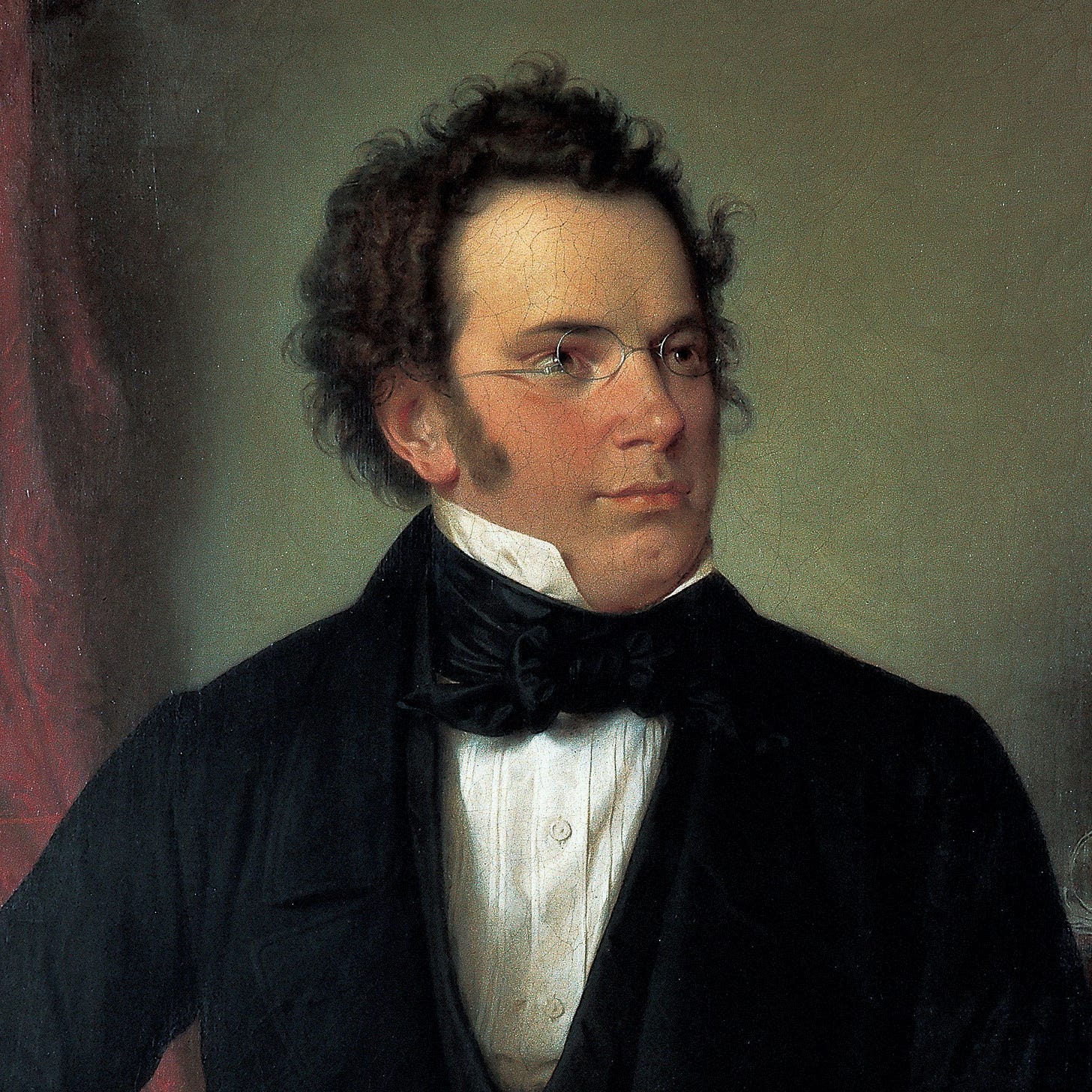
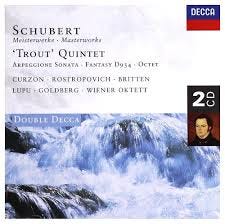
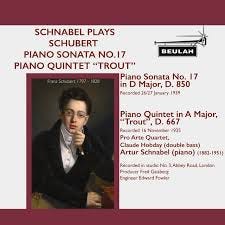
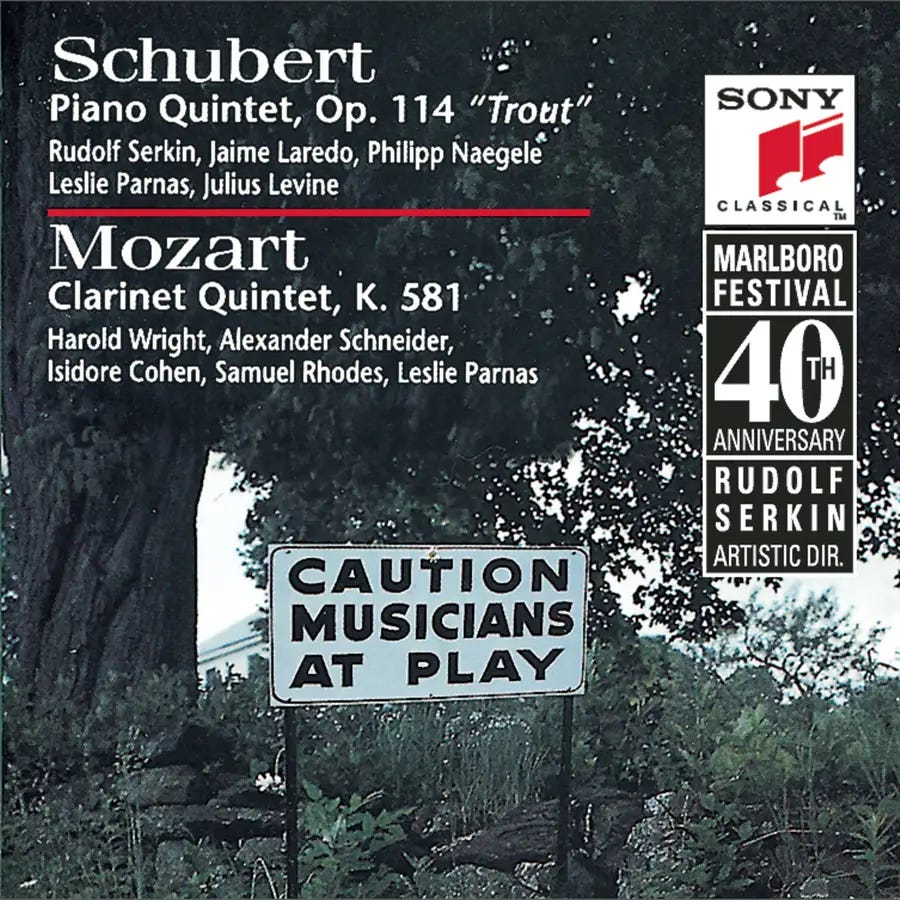
![Beaux Arts Trio – Schubert 'Trout' quintet - Beethoven 'Ghost' trio – CD (Digitally, Remastered, Stereo), 1992 [r11728851] | Discogs Beaux Arts Trio – Schubert 'Trout' quintet - Beethoven 'Ghost' trio – CD (Digitally, Remastered, Stereo), 1992 [r11728851] | Discogs](https://substackcdn.com/image/fetch/$s_!IA15!,w_1456,c_limit,f_auto,q_auto:good,fl_progressive:steep/https%3A%2F%2Fsubstack-post-media.s3.amazonaws.com%2Fpublic%2Fimages%2F03b65609-d660-415c-8a31-273579b0d593_600x600.jpeg)

